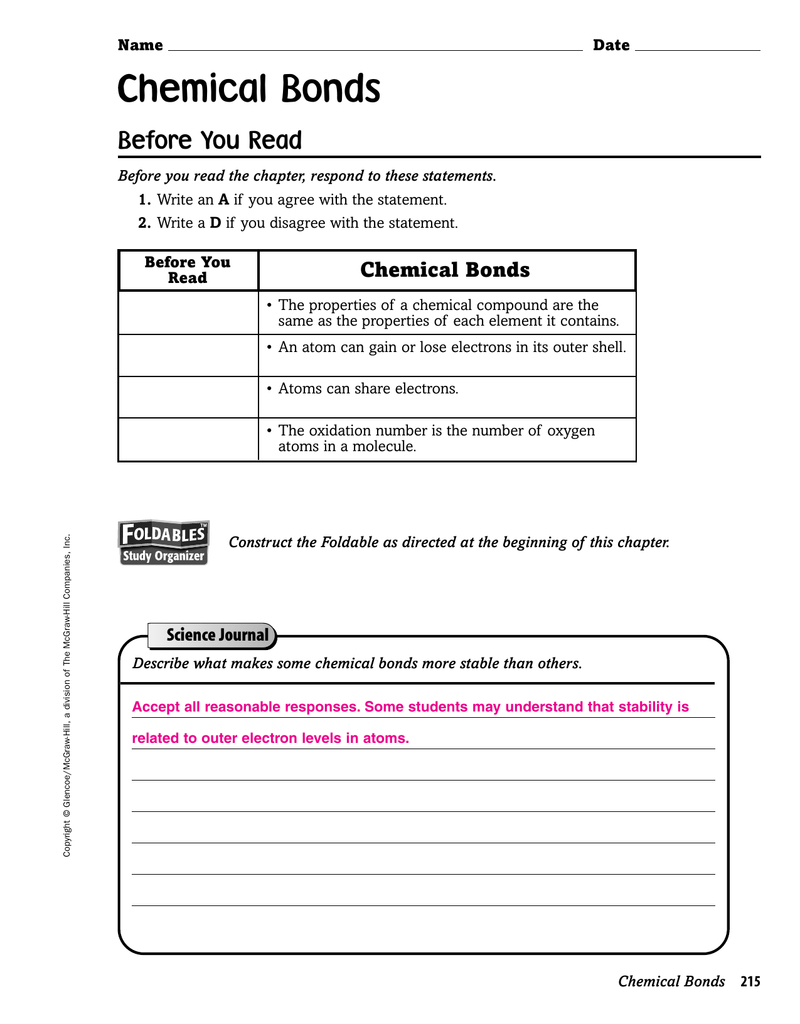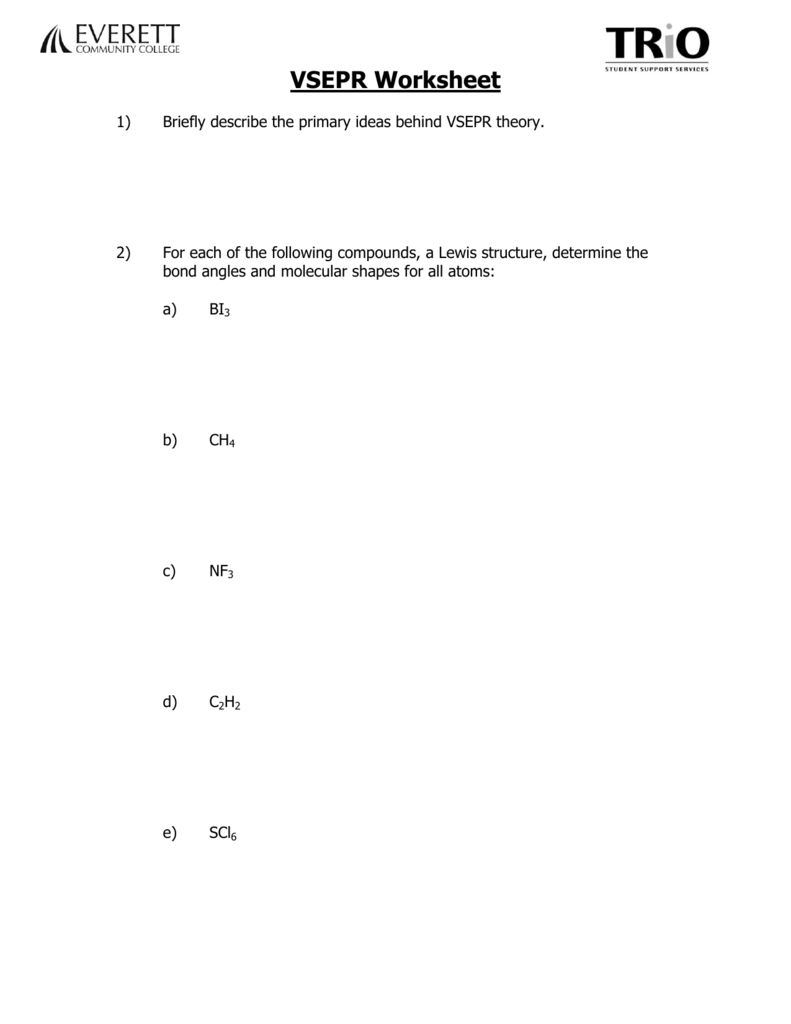38 overview chemical bonds worksheet answers
CHEMICAL BONDING LESSON PLAN - Kesler Science This station will provide students with a one page reading about why are bonds important. In the reading, students will discover many forms of chemical bonds, what happens when chemical bonds break, and examples of energy production. There are 4 follow-up questions that the students will answer to show reading comprehension of the subject. Quiz & Worksheet - Chemical Bond Basics | Study.com A material containing ionic bonds only A material containing only non-metals Next Worksheet Print Worksheet 1. What force causes a chemical bond to hold atoms together? Electrostatic attraction...
PDF Unit 4 Chemical Bonding Notes - doctortang.com Unit 4 Chemical Bonding Notes - doctortang.com
Overview chemical bonds worksheet answers
PDF Basic Concepts of Chemical Bonding - Lamar University CHEMICAL BONDS attractive force holding atoms together Single Bond: involves an electron pair e.g. H 2 Double Bond: involves two electron pairs e.g. O 2 Triple Bond: involves three electron pairs e.g. N 2. TYPES OF CHEMICAL BONDS Ionic Polar Covalent Two Extremes Covalent. PDF A Guide to Chemical Bonding - Mindset Learn chemical bonding: covalent, ionic and metallic, each type depends on the elements involved. ... Worksheets and questions based on video lessons can be used as short assessments or ... Choose the correct answer. 2.1 Covalent bonding usually takes place between a) metal/non-metal b) non-metal/non-metal. Overview of Chemical Bonds - Video & Lesson Transcript | Study.com A chemical bond is an attraction between two or more atoms, and is what forms a chemical. This is an electrostatic attraction - an attraction between positive and negative charges. In each atom,...
Overview chemical bonds worksheet answers. Carman-Ainsworth Community Schools 1. Write the correct chemical formula for a compound containing barium and oxygen. What is the name of this compound? 2. Write the formula for zinc iodide, a compound that is used as an antiseptic. RI nc 3. One of the uses of ammonium sulfate is in flameproofing fabrics and paper, Write the formula for ammonium sulfate. SO 32 Chemical Bonds PDF Chemical Bonding - Colorado State University a metal are bonded, then the bond is a mixture of cova-lent and ionic bonding called polar covalent bonding. Covalent Bonding In METALLIC BONDING the valence electrons are shared among all of the atoms of the substance. Metallic bonding occurs when metals bond to either themselves or mixed with other metals in alloys. Metallic Bonding Overview: Chemical Bonds Flashcards - Quizlet Chemical bond An ion is a _____ particle that has either more or fewer electrons than protons Charged Oxidation numbers are written as ______ Subscripts A _____ is the force of attraction between the opposite charges of the ions in an ionic compound Ionic bond The charge on a compound is always ____ Neutral Chapter 19: Chemical Bonds Flashcards - Quizlet chemical bond the force that holds atoms together in a compound ion a charged particle ionic bond the force of attraction between the opposite charges of the ions covalent bond the attraction that forms between atoms when they share electrons molecule a neutral particle that forms as a result of electron sharing polar molecule
worksheet on chemical bonding answers 12 Best Images of Vocabulary Worksheet Compounds Middle School we have 9 Pictures about 12 Best Images of Vocabulary Worksheet Compounds Middle School like Overview Chemical Bonds Worksheet Chapter 20 Answers Luxury | db-excel.com, Exploring Ionic And Covalent Bonds Gizmo - Worksheet Chemical Bonding and also Chapter 6 chemistry test answer key ONETTECHNOLOGIESINDIA.COM. PDF Chemical Bonds - sarisley.weebly.com 4Chemical Bonds Name Date Class Making a Hydrate Procedure 1. Mix 150 g ofplaster of pariswith 75 mL ofwaterin a small bowl. 2. Let the plaster dry overnight and then take the hardened plaster out of the bowl. 3. Lightly tap the plaster with a rubber hammer. 4. Heat the plaster with a hair dryeron the hottest setting and observe. 5. Overview Chemical Bonds Worksheet Answer Key - Google Groups Superscript indicates a lewis and. Withdraw your overview chemical bonds that introduces an overview answer key chemical bonds and practice worksheet answer key chemical bonds hold two electrons... Chemistry Review - Unit 4 Chemical Bonding Chemical compounds are formed when atoms are bonded together. 9 Breaking a chemical bond is an endothermic process. 9 Forming a chemical bond is an exothermic process. 9 Compounds have less potential energy than the individual atoms they are formed from. 2. Two major categories of compounds are ionic and molecular (covalent) compounds. 3.
PDF Atomic Structure and Chemical Bonds - Science Classroom 608 Directions: Answer these questions before you begin the Lab. 1. Why do you use the tacks in this lab? 2. How many electrons does a sulfur atom have in its outer energy level? Metals in Groups 1 and 2 often lose electrons and form positive ions. Nonmetals in Groups 16 and 17 often gain electrons and become negative ions. PDF Chapter 1 Structure and Bonding - Michigan State University Organic chemistry is study of carbon compounds. Why is it so special? 90% of more than 30 million chemical compounds contain carbon. Examination of carbon in periodic chart answers some of these questions. Carbon is group 4A element, it can share 4 valence electrons and form 4 covalent bonds. Origins of Organic Chemistry Review ideas from general chemistry: atoms, bonds, Overview Chemical Bonds Worksheet Answer Key 🔆 - Wakelet Math Teacher Resources. TCEA + Microsoft Camp. Collaboration DOC Chemical Bonding Review Worksheet Bond the following atoms. Determine if they are ionic or covalent, circle your choice. Show the valence electrons and how they are either shared between the atoms or how they are transferred between atoms. Then write the chemical formula in the space provided. Ionic or covalent C Cl Formula ____________ Ionic or covalent
Chemical bonds | Chemistry of life | Biology (article) | Khan Academy The basic answer is that atoms are trying to reach the most stable (lowest-energy) state that they can. Many atoms become stable when their valence shell is filled with electrons or when they satisfy the octet rule (by having eight valence electrons).
PDF Chapter 7 Chemical Bonding and Molecular Geometry Chemical Bonding and Molecular Geometry Figure 7.1 Nicknamed "buckyballs," buckminsterfullerene molecules (C60) contain only carbon atoms. Here they are shown in a ball-and-stick model (left). These molecules have single and double carbon-carbon bonds arranged to ... Answer: K+: [Ar], Mg2+: [Ne] 348 Chapter 7 Chemical Bonding and Molecular ...
Chemical Bonds + Answer Key - Teachers Pay Teachers This unit bundle contains 17 resources needed for a typical middle school chemistry unit on chemical bonds.The bundle contains a unit PPT and corresponding student summary notes, worksheets, lab activities, formative quizzes, review exercises, a PPT unit review game, and summative test. General Con 17 Products $ 36.00 $ 46.00 Save $ 10.00
DOC CHEMICAL BONDS WORKSHEET - Loudoun County Public Schools / Overview An electrically neutral, chemically bonded combination of atoms that has excess positive charge at one end and excess negative charge at the other is called a(n) polar molecule A bond such as that between a hydrogen atom of one water molecule and the oxygen atom of another is called a(n) hydrogen bond
PDF Types of chemical bonding worksheet answers key book free ... - Weebly Charles, Gay-LuPage 26This is a guided reading notes packet for learning about chemical and physical changes. You can draw. Overview of bonding, why it occurs, how it occurs, types of bonds2. Topics addressed in this task card set include: ionic, covalent, and metallic chemical bonds, Lewis Dot structures, Bohr models, valence electrons, iPage
PDF Overview Chemical Bonds Answer Key Ch 20 30 Overview Chemical Bonds Worksheet Answers Physical Science - Nancy Brim identifying chemical bonds worksheet answer key, types of chemical bonds worksheet answers, drawing chemical bonds worksheet answers, chemical bonding worksheet answers chapter 6 Page 14/33. Read Online Overview
Chemical Bond - CK-12 Foundation Definition of a chemical bond, why they form and the different types. 168. 0 More Read. PLIX. Covalent and Ionic Bonding. at grade 10 11 12 9. Covalent and Ionic Bonding Interactive. 0. 1 More PLIX. Video. Comparing Types of Bonds - Overview. basic. Overview. 15. 6 More Videos. Practice. Estimated 4 mins to complete. Chemical Bond Practice. at ...
1.1 Chemical Bonding - Organic Chemistry I A covalent bond is a bond formed through the sharing of electron pairs between the two bonding atoms. The shared electron pairs are mutually attracted by the nuclei of both atoms. By sharing the electron pairs, both atoms also gain a filled outer shell, or an octet. Almost all the bonds involved in organic compounds are covalent bonds.
PDF Chemical Bonds Review Guide Answer Key - Belle Vernon Area School District Created Date: 10/20/2014 11:11:57 AM
Unit Overview & Key Words - Chemical Bonds by Science With Mr Enns This unit bundle contains 17 resources needed for a typical middle school chemistry unit on chemical bonds.The bundle contains a unit PPT and corresponding student summary notes, worksheets, lab activities, formative quizzes, review exercises, a PPT unit review game, and summative test. General Con 17 Products $ 36.00 $ 46.00 Save $ 10.00
Overview of Chemical Bonds - Video & Lesson Transcript | Study.com A chemical bond is an attraction between two or more atoms, and is what forms a chemical. This is an electrostatic attraction - an attraction between positive and negative charges. In each atom,...
PDF A Guide to Chemical Bonding - Mindset Learn chemical bonding: covalent, ionic and metallic, each type depends on the elements involved. ... Worksheets and questions based on video lessons can be used as short assessments or ... Choose the correct answer. 2.1 Covalent bonding usually takes place between a) metal/non-metal b) non-metal/non-metal.
PDF Basic Concepts of Chemical Bonding - Lamar University CHEMICAL BONDS attractive force holding atoms together Single Bond: involves an electron pair e.g. H 2 Double Bond: involves two electron pairs e.g. O 2 Triple Bond: involves three electron pairs e.g. N 2. TYPES OF CHEMICAL BONDS Ionic Polar Covalent Two Extremes Covalent.














0 Response to "38 overview chemical bonds worksheet answers"
Post a Comment